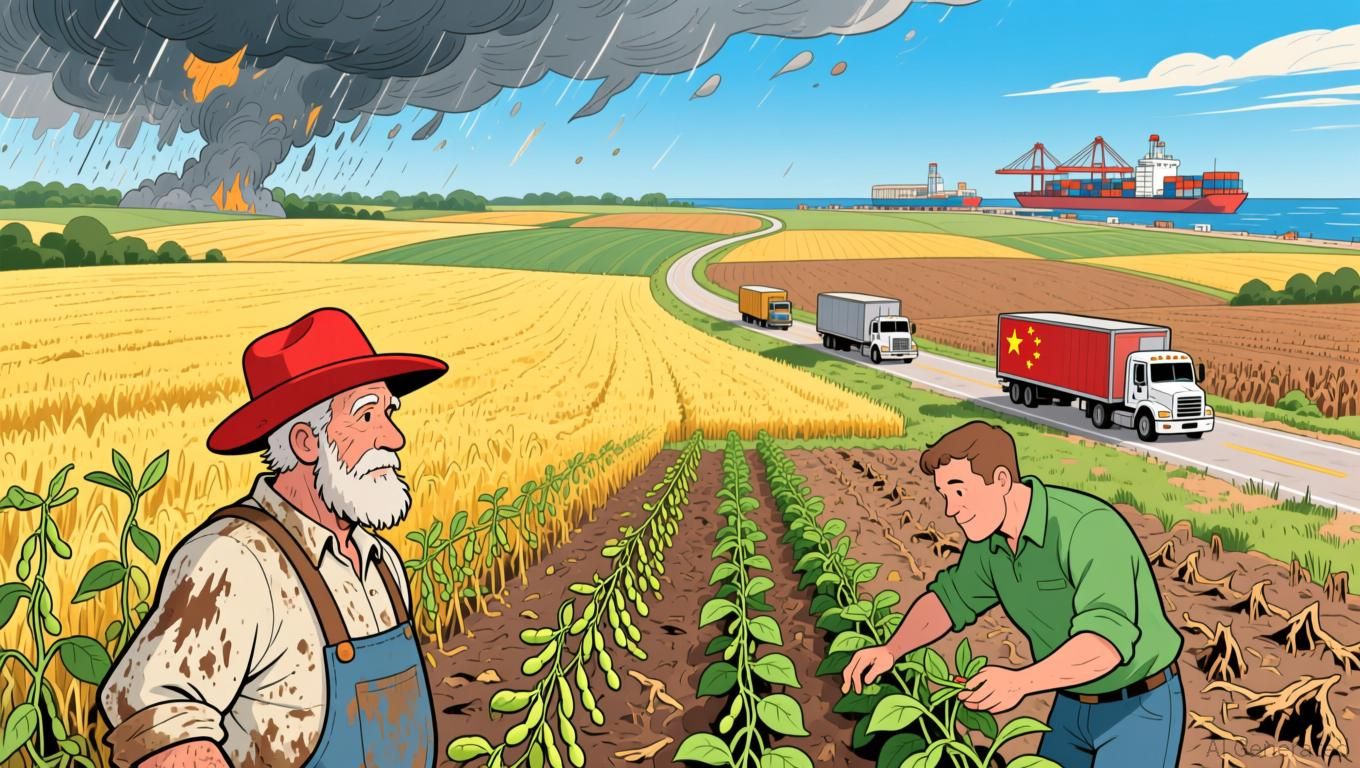China’s Influence on Soybean Trade and a Failing System Push U.S. Farmers into Turmoil
- U.S. rural farmers face crisis as China's reduced soybean purchases and trade disputes drive plummeting prices and high debt. - Federal aid programs provide short-term relief but fail to address systemic issues like inflated land prices and structural profitability gaps. - Trump's trade policy adjustments offer mixed signals, temporarily easing tariffs on imports while China maintains residual soybean duties as geopolitical leverage. - Record farm debt and grocery insecurity highlight a K-shaped recovery
The agricultural economy in rural America is experiencing an uneven recovery, with government assistance reaching emergency levels as ongoing trade conflicts and deep-rooted challenges widen the gap between struggling farmers and more stable agricultural sectors. The situation has worsened due to China's ongoing hesitation to resume significant U.S. soybean imports, leaving farmers in the Midwest facing falling prices, rising production expenses, and unpredictable trade regulations. Meanwhile,
The trade standoff over soybeans between the U.S. and China has become a central issue in the economic hardships facing rural communities. Since October 2025, China has committed to buying 12 million metric tons of U.S. soybeans—less than half of the 26.8 million metric tons it imported in 2024. This gap has left Wisconsin's soybean farmers—whose industry is worth $1.3 billion a year—dealing with losses as global prices drop. "The unpredictability of trade policy has added more pressure on farmers who are already struggling to make future plans," stated Paul Mitchell, an agricultural economics professor at the University of Wisconsin-Madison

The federal response has included emergency support, such as $30 billion in relief for Emergency Commodity Assistance and Supplemental Disaster Relief programs. Still, critics argue these efforts fall short, often driving up land values instead of improving farm profitability. "Farmers are stuck in a dysfunctional system," said Joe Maxwell from Action Farm Fund, a farmer advocacy group. "We keep spending on temporary solutions while the core issues in agriculture remain unaddressed"
Recent changes in trade policy under President Donald Trump have sent mixed messages. On November 13, Trump issued an executive order that exempts major agricultural imports—such as Indian spices, coffee, and tropical fruits—from a 50% tariff increase, citing concerns over rising domestic prices. This move, part of broader trade talks, is intended to lower food costs for Americans and reduce pressure on importers. In a separate agreement, China has paused retaliatory tariffs on U.S. soybeans in return for reduced U.S. tariffs, though a 13% duty still applies
The pronounced split in the farm economy underscores the vulnerability of rural livelihoods. While large agribusinesses and major producers are able to adjust to changing trade conditions, smaller farms are facing severe risks. The latest figures from the Federal Reserve indicate that farm debt has hit unprecedented levels, with
Disclaimer: The content of this article solely reflects the author's opinion and does not represent the platform in any capacity. This article is not intended to serve as a reference for making investment decisions.
You may also like
Bitcoin News Today: "As ETFs Experience Rapid Growth, Metaplanet Remains Steadfast in the Battle for Bitcoin Leadership"
- Metaplanet holds 30,823 BTC, aiming for 210,000 by 2027 via preferred shares. - MicroStrategy's market value discounts raise debt concerns despite CEO's confidence. - ETF growth and institutional interest shift Bitcoin's perception as a long-term asset. - Japan's $2T assets drive Metaplanet's Bitcoin-backed fixed-income strategy.

Bitcoin News Today: Bitcoin’s Plunge Below $96K Sparks Concerns Over a Bear Market Resurgence Similar to 2024
- Bitcoin fell below $96,000, erasing 2025 gains and triggering $44M in liquidations as ETF outflows hit $870M. - Market cap dropped 5.4% to $3.36T, with Ethereum and XRP hitting multi-month lows amid weak demand. - Chain metrics show 815,000 BTC sold by long-term holders, while Bull Score Index collapsed to 20 from 80. - Technical indicators warn of further declines below $93,500, testing 2024 bear market lows if support breaks. - MicroStrategy added $835M BTC despite criticism, but fear/greed index hit 1
Bitcoin News Today: Bitcoin ETFs See $870M Outflow as Long-Term Holder Selling Drives Price Near $80k
- Bitcoin’s price nears $80,000 as fear indices hit 16, signaling panic-driven capitulation. - $870M ETF outflows and 815,000 BTC sold by LTHs accelerate downward pressure since October. - Key technical levels breached: 365-day SMA broken, 50-week SMA at risk, bear market risks rising. - Ethereum faces 200-day EMA resistance; whales accumulate ETH despite $3.66B in ETF outflows. - STHs near 12.79% losses, 6-12M holder cost basis at $94,000 may offer temporary support.

Bitcoin News Update: Bitcoin ETF Sees $1.5 Billion Withdrawals While Institutional Investors Increase Their Holdings
- BlackRock's IBIT ETF saw $1.5B net outflows over 10 days as investors reassess Bitcoin exposure amid volatility. - Harvard University boosted IBIT holdings to $442.8M, surpassing its combined stake in major tech firms, while diversifying into gold . - Institutional ownership in IBIT rose to 29% QoQ, with UAE entities and sovereign wealth funds among key holders, signaling crypto's growing institutional acceptance. - KuCoin expanded institutional services as ETF outflows highlight market recalibration, wi